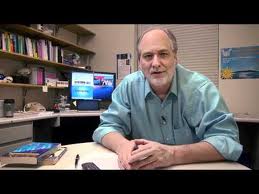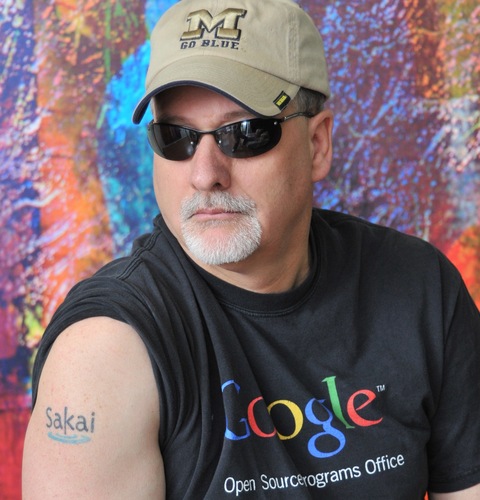Ask Dr. Chuck
OK, OK. I am sorry. I got lost again this morning on the way to something else.
You love Mondays as much as I do, right? I think the only people who could possibly love it less are the Republican National Committee who are sitting in the rain in Tampa. But I got one of those icy-cold spasms when I remembered what I had forgotten. This was bad. Periodically, I get notes on the computer from Dr. Chuck, the University of Michigan Information School Professor with whom I have had a recent relationship.
No, not that kind of relationship. This one is virtual. Not that there is anything wrong with it. I signed up for a Coursera offering by the good doctor on “The History of the Internet.”
A word of explanation if you are not hooked up to the latest Transformation of Everything You Know. I began this all when a pal highlighted an outfit called “Coursera.” They are a social entrepreneurship company that partnered with several brick-and-mortar universities around the world, including my own University of Michigan. The eventual for-profit institution (it isn’t at the moment) offers courses online for anyone to take, for free. They are trying to wrest a future into being where the prestigious is available not to those whose resumes and test scores (and financial wherewithal) have granted physical admission to campus. They envision a future where the top universities are educating “not only thousands of students, but millions.”
I thought it was interesting, and the application of technology to enable the leading scholars from a myriad of disciplines to tens or hundreds of thousands of students.
I have apparently joined “a global community of thousands of students learning alongside me.” We had a peer-graded written assignment that abundantly demonstrated the truthiness of that- the five essays I reviewed were all penned by non-native English speakers and frankly incoherent, which caused Dr. Chuck to ink a change to the peer-review process in Week Three.
Coursera is a bold concept. They intend to offer a wide palate of learning: Humanities, Medicine, Biology, Social Sciences, Mathematics, Business, Computer Science, and many others.
I signed up for the internet course because Dr. Charles Severance- Dr. Chuck- is from my alma mater, and I thought that would be a good place to start on this distance learning crap I hope (someday) to cobble into using my GI Educational benefits. I trust the brand, the Michigan part, though I have no idea what to think of Coursera.
Chuck is a piece of work, a tech geek and motocross aficionado, who is herding some 30,000 students through the material of the social, biographic and technical underpinnings of how we communicate and interact.
I think the total enrolled topped 40,000 students in the History of the Internet course- which yielded, at the end of the first two weeks, an effective participatory body of 10,000 co-students, which would beat the chaos of any 101-level survey course I ever took in a real school.

(Dr. Chuck streaming- Live! Image Capture Coursera)
Dr. Chuck is a quirky character- his personal history, like ours- is about that of the internet. He was a player in the early tutorial applications, and specializes now in drawing highlight scrawls on the viewgraphs that accompany his streaming video discourse.
We started with the ubiquitous Bletchley Park, and our shared legacy of the cryptographic assault on the Nazi military codes. The course narrative ran from the Turing Engine and the ENIAC through the ARPANet and CERN and the World Wide Web in Switzerland and Gopher and Mosaic and NSFNet and finally the web we depend upon today, and which provides easy shopping, dirty pictures and a place for the Russian and Chinese thugs to operate in the comfort and safety of our own laptops.
Dr. Chuck marks the take-off as happening in 1994. I wrote my first peer-reviewed essay in Week Two, explaining that military intelligence had been networked as early as 1979, and that we had been immersed in web applications ever since. I think back to the Secure Analyst File Environment (SAFE, and no, it wasn’t) at DIA in 1990 as the watershed when my world changed.
Prior to DESERT SHEILD, my standard of success was to get to the message board first, count coup on the traffic, and read, if possible, every piece of paper that came to the Command from Main Comm.
When I arrived at the Pentagon, they taught me to set the aperture filter wide on my SAFE profile, since I was doing Air Defense, Naval Activity and sanctions enforcement. I immediately started to get tens of thousands of messages in the queue. I could not physically read even a tenth of it, and I realized to my growing horror, that I could not guarantee that I was seeing the messages I needed to do my job. I was awash in data- submerged in it.
For me, the summer of 1990 was when the new world was born. Dr. Chuck will tell you it is 1994- but our networks were still ahead of the commercial world then.
That might be a useable thought. Perhaps I can use that and riff it into the optional essay for extra credit in Week Six?
So, that gets me around to Monday after thinking about nothing in particular all weekend, and that is when the chill realization that Week Five will slip into last week’s assignment at midnight tonight, and I had done nothing about it. So, in the post-sleep grogginess and first course of caffeine through my veins, I embarked on the three video lectures before breakfast program.
We are into “the stack,” a term of art by which Dr. Chuck describes the functions of the architectural layers of the web. He starts with the “physical layer” of the internet, and archana like how the Carrier Sense Media Access/Collision Detection (CSMA/CD) acts within the Link Layer, then progressing up to the IP layer.
There is a transport layer above that- Week Six- and the peer-to-peer layer that gets to Applications and what you do with the data once it arrives to the host computer where it is reassembled into something useful.
I was lucky to understand IP addresses, static and dynamic, and the Network Address Translation (NAT) loop, and even how to summon a trace route to track packet routing, along with the link to the TTL- “Time to Live” function that kills packets that wind up in data loops after 255 hops.
Do I really understand any of this crap?
I doubt it, though I did score a 10-out-of-10 on the Week Five Quiz, yielding a cumulative score of 49 out of 50 possible points for the first five weeks. There are only two weeks to go- with 30 points riding on the final, and an optional essay that I can attempt for extra credit.
I don’t know why I would do that, but there is supposed to be a certificate of some kind if I am alert enough to remember the last two weeks.
It has given me some great useless information: IP addresses are read properly left-to-right, and astonishingly, Domain Names are read the other way- the computers shred things by the “.org,” or “.com” first, and then eventually get to the “www.”
Amazing stuff. I knew only the bits that actually impact or have impacted our lives, and am toying with the idea of using the GI Bill to get some sort of cyber certificate, of which this was a little toe-dip into the world of distance learning.
Dr. Chuck even has office hours, just like real college, and he has been popping up like a Whack-a-Mole in coffeehouses across the nation. He is going to be in one here in DC tomorrow, in the basement of a place called Teaism at 400 8th Street NW. I may attend as part of this ongoing experiment in whether or not education is another one of those things that is in transformation.
I will ask Dr. Chuck, if I see him in the flesh tomorrow. Happy Learning.

(Geek ink. Photo Severance.)
Copyright 2012 Vic Socotra
www.vicsocotra.com
